
The New Zealand demoiselle, Chromis dispilus, is a damselfish of the genus Chromis, found between North Cape and East Cape of the North Island of New Zealand to depths of about 60 metres, off rocky coasts. Its length is between 15 and 20 cm. Males are highly territorial as they defend their nesting area from other males and other species. These aggressive fish defend their eggs laid by their female counterpart. Spawning occurs between the months of December and March. The New Zealand demoiselle's territory and nesting grounds of this fish are usually the largest in a medium population density. Like most territorial fish they tend to spawn more in higher densities of the same species compared to lower densities. Aggression levels tend to be higher amount higher densities of the same species and lower levels in smaller densities. Aggression also tends to be higher during spawning then during egg defending. Elevated plasma levels of androgen testosterone and 11-Ketotesterone are associated with the heighten levels of aggression shown by the males.
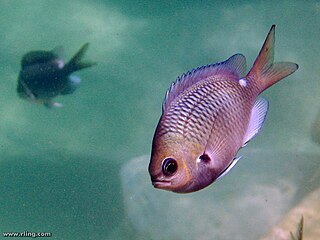
The one-spot puller or brown puller, Chromis hypsilepis, is a damselfish of the genus Chromis, found off south-east Australia and between North Cape and East Cape of the North Island of New Zealand to depths of about 60 metres, off rocky coasts. It grows to a length between 15 and 20 centimetres.

Chromis is a genus of fish in the family Pomacentridae. While the term damselfish describes a group of marine fish including more than one genus, most damselfish are in the genus Chromis. These fish are popular aquarium pets due to their small size, tolerance for poor water quality, and bright colors, though their lifespans tend to be shorter than other fish.

The black ruff is a medusafish, the only member of the genus Centrolophus. It is a bathypelagic fish found in all tropical and temperate oceans at depths of 50 to 1,000 m. Its length is typically up to 60 cm (24 in), but it may reach 150 cm (60 in). Other common names include rudderfish and blackfish.
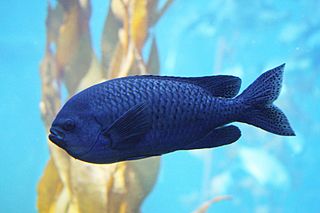
The blacksmith, also known as the blacksmith chromis and blacksmith damselfish, is a fish in the damselfish family. It is native to the northeastern Pacific Ocean, where it range is from Monterey Bay, California, USA, to central Baja California, Mexico. This small fish is associated with rocky reefs and kelp forests.
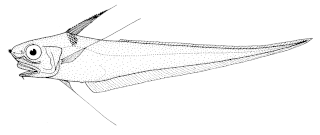
The long-rayed whiptail or four-rayed rattail, Coryphaenoides subserrulatus, is a rattail of the genus Coryphaenoides, found circumpolar in all southern oceans, at depths between 550 and 1,200 m. Its length is between 20 and 37 cm.

The slender tuna, Allothunnus fallai, is a species of tuna, the only species in the genus Allothunnus, found around the world in the southern oceans between latitudes 20° and 50° South, although there are two records of probable vagrants, one in Los Angeles Harbour and the other from the North Pacific subarctic gyre. It has a more elongated body than other species of tuna with which it is symaptric such as the albacore The colour is blue-black on the back with silvery greyish-white sides, however some individuals have a coppery sheen soon after capture. It has a small second dorsal and anal fins resembling a small albacore, but the slender tuna lacks the long sweeping pectoral fins characteristic of albacores. The pectoral fins and pelvic fins are purple on their distal portions and black near their bases. Its length is up to 1 metre (3.3 ft) and it can weigh up to 12 kilograms (26 lb). It occasionally forms schools and its main prey is krill but it is also known to prey on squid and smaller fishes, such as jack mackerel. It is a species of minor commercial importance, taken mainly as bycatch by fisheries for other tuna species. It has rather oily flesh, paler than that of other tuna, but the flesh is palatable when cooked, although it is suitable for canning. The high oil content of the flesh is caused by the oily nature of its diet and varies over the tuna's life, fish which have just fed are high in oil but specimens caught at the end of their migrations will have relatively low oild content. The high concentration of omega-3 polyunsaturated fatty acids in the flesh of this species caused the CSIRO to declare that the slender tuna was Australia's healthiest seafood dish.

The longnose spurdog is a dogfish shark of the genus Squalus, found over continental shelves in all oceans, at depths of between 15 and 800 metres. They reach one metre in length.

The samson fish is a jack of the genus Seriola. It is found in the Indo-Pacific Oceans to eastern Northland in New Zealand. Its length is between 80 and 150 cm.
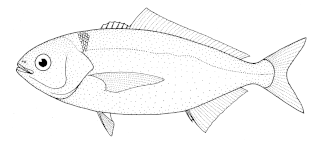
The white warehou, Seriolella caerulea, is a medusafish of the family Centrolophidae found in the southern Pacific and southern Atlantic oceans, at depths of between 500 and 800 m. Its length is up to about 75 cm.
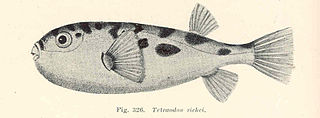
The prickly toadfish is a pufferfish of the family Tetraodontidae, found in the eastern Indian Ocean and the southwest Pacific Ocean, at depths down to 50 m. Its length is up to 25 cm.

The starry toado is a pufferfish of the family Tetraodontidae, found in subtropical oceans worldwide, at depths between 10 and 360 m. Its length is up to 40 cm.
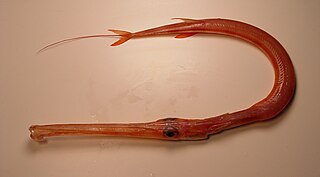
The red cornetfish, also known as the rough flutemouth, is a cornetfish of the family Fistulariidae, found in subtropical and tropical oceans worldwide, at depths between 10 m (33 ft) and 200 metres (660 ft). They are up to 2 m (6.6 ft) in length but rarely exceed 1 m (3.3 ft).

The spiny pipehorse is a pipefish of the family Syngnathidae, found in the southwest Pacific Ocean on rocky or coral reefs to depths of 230 metres (750 ft). Length is up to 50 centimetres (20 in).

Chromis viridis is a species of damselfish. Individuals tend to be iridescent apple-green and light blue, and reach a maximal length of 10 cm.
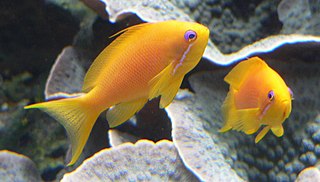
The sea goldie, also known as the orange basslet, lyretail coralfish, lyretail anthias, lyretail fairy basslet, orange fairy basslet, orange seaperch, scalefin basslet, scalefin fairy basslet and scalefin anthias, is a species of marine ray-finned fish, an anthias from the subfamily Anthiinae part of the family Serranidae, the groupers and sea basses. It has a wide Indo-Pacific distribution. It is found in the aquarium trade.
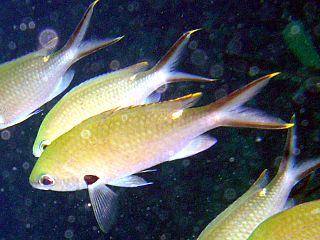
Chromis multilineata is a species of fish in the family Pomacentridae. It is commonly known as the brown chromis. It is found in the western Atlantic Ocean from the southern United States south to Brazil and in the eastern Atlantic off St Helena and Ascension Island

The yellowtail reeffish is a species of damselfish in the family Pomacentridae. It is native to the Atlantic Ocean. Occasionally, they are found in the aquarium trade.
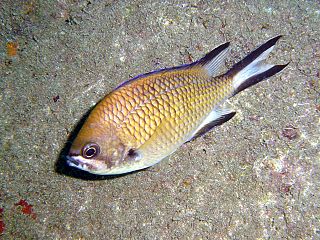
The Azores chromis or Atlantic chromis is a species of damselfish from the family Pomacentridae which is found in the Macaronesian Islands of the temperate eastern Atlantic Ocean and has been reported from coastal regions of western Africa.
Chromis lubbocki is a species of marine fish of the family Pomacentridae. This fish grows to 12.5 cm maximal length. It occurs in the eastern Atlantic Ocean, off the coast of Cape Verde. The specific name honours the marine biologist Hugh Roger Lubbock (1951-1981) who led the Cambridge Expedition to Saint Paul's Rocks, part of the Cape Verde Islands, who collected the type specimen and realised it was a new species.




















